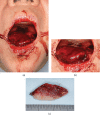Two Cases of Nonsuicidal Self-Injury Comprising Partial Autoamputation of the Apex of the Tongue
- PMID: 32148976
- PMCID: PMC7057006
- DOI: 10.1155/2020/8691270
Two Cases of Nonsuicidal Self-Injury Comprising Partial Autoamputation of the Apex of the Tongue
Abstract
The prevalence of nonsuicidal self-injury (NSSI) in adults is lower than that in adolescents and it is more prevalent in patients with psychiatric disorders. Sleep disturbances such as nightmares are associated with NSSI after accounting for depression; thus, persons with major NSSI sometimes present at medical institutions during the night seeking emergency treatment. Gingival tissues comprise the most frequent target of self-injury of the oral cavity using oral hygiene tools. Most NSSI in the oral cavity is minor because such tools are blunt. Major NSSI such as autoamputation of the tongue is rare. We describe two patients who partially autoamputated the apex of their own tongues using edged tools. Case 1 was a 55-year-old female with depression who had defaulted from psychiatric intervention. She had cut off her tongue using a Japanese kitchen knife and presented with the dry, necrotic amputated portion and blood oozing from the remainder of her tongue. We debrided and sutured the remainder of the tongue without reattaching the amputated portion. Her postoperative course was uneventful, and she was free of adverse events such as functional disability and wound infection. Case 2 was a 69-year-old female with schizophrenia who had defaulted from psychiatric intervention and had cut off her tongue using scissors. The amputated portion of the tongue was lost and the remainder, which was oozing blood, was debrided and sutured. She defaulted on a follow-up appointment. Neither of these patients had suicidal intent. The prevalence of NSSI across all age groups has recently increased, and the risk that self-injury will become normalized has become a concern. Thus, dentists as well as oral and maxillofacial surgeons should be aware of the possibility that patients will present with major NSSI requiring emergency treatment.
Copyright © 2020 Takashi Moriya et al.
Conflict of interest statement
None of the authors have any conflicts of interest to declare.
Figures




Similar articles
-
Nightmares Are Associated With Future Suicide Attempt and Non-Suicidal Self-Injury in Adolescents.J Clin Psychiatry. 2019 May 28;80(4):18m12181. doi: 10.4088/JCP.18m12181. J Clin Psychiatry. 2019. PMID: 31141321
-
Nightmares and nonsuicidal self-injury: The mediating role of emotional dysregulation.Compr Psychiatry. 2017 Jul;76:104-112. doi: 10.1016/j.comppsych.2017.04.003. Epub 2017 Apr 18. Compr Psychiatry. 2017. PMID: 28456054
-
Nonsuicidal self-injury in a naturalistic sample of adolescents undergoing inpatient psychiatric treatment: prevalence, gender distribution and comorbidities.Psychiatr Danub. 2017 Dec;29(4):522-528. doi: 10.24869/psyd.2017.522. Psychiatr Danub. 2017. PMID: 29197214
-
Impulsivity and nonsuicidal self-injury: A review and meta-analysis.Clin Psychol Rev. 2015 Jun;38:13-24. doi: 10.1016/j.cpr.2015.02.010. Epub 2015 Mar 7. Clin Psychol Rev. 2015. PMID: 25779460 Review.
-
Nonsuicidal self-injury in adolescents: current developments to help inform assessment and treatment.Curr Opin Pediatr. 2018 Aug;30(4):483-489. doi: 10.1097/MOP.0000000000000655. Curr Opin Pediatr. 2018. PMID: 29846251 Review.
Cited by
-
Parents' lived experience of adolescents' repeated non-suicidal self-injury in China: a qualitative study.BMC Psychiatry. 2022 Jan 28;22(1):70. doi: 10.1186/s12888-022-03715-7. BMC Psychiatry. 2022. PMID: 35090423 Free PMC article.
References
-
- Wilkinson P., Kelvin R., Roberts C., Dubicka B., Goodyer I. Clinical and psychosocial predictors of suicide attempts and nonsuicidal self-injury in the Adolescent Depression Antidepressants and Psychotherapy Trial (ADAPT) The American Journal of Psychiatry. 2011;168(5):495–501. doi: 10.1176/appi.ajp.2010.10050718. - DOI - PubMed
Publication types
LinkOut - more resources
Full Text Sources
Miscellaneous

